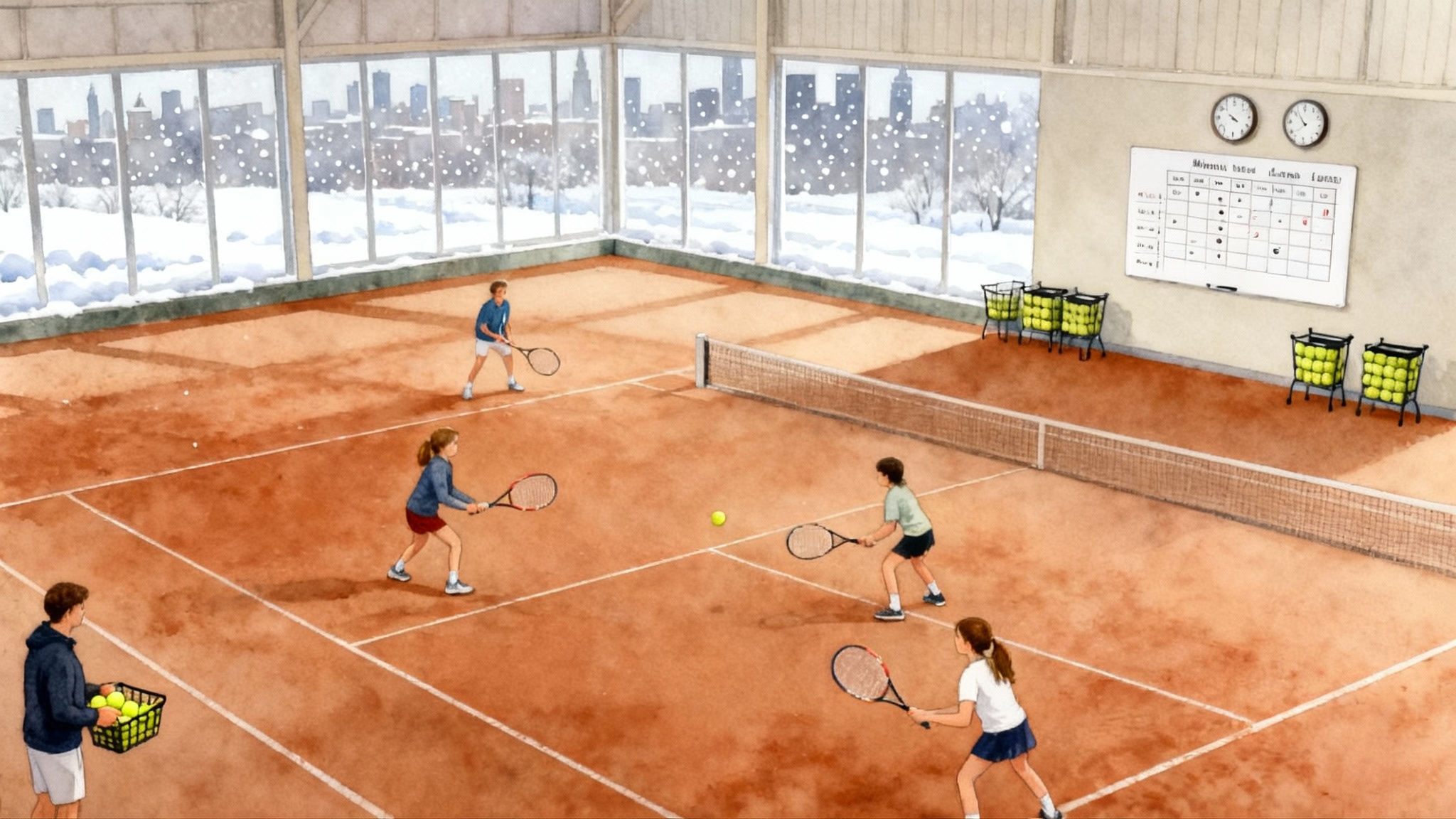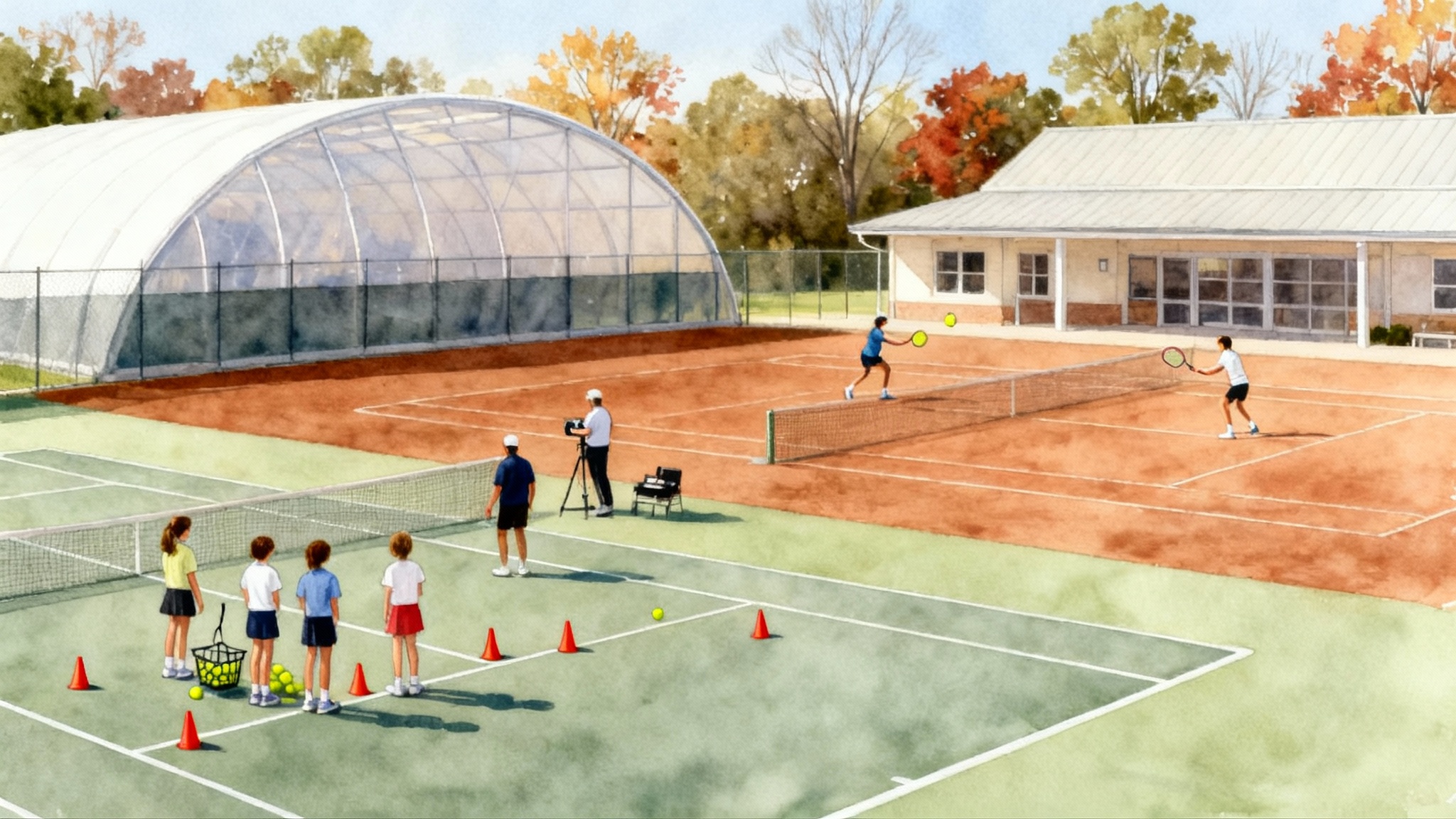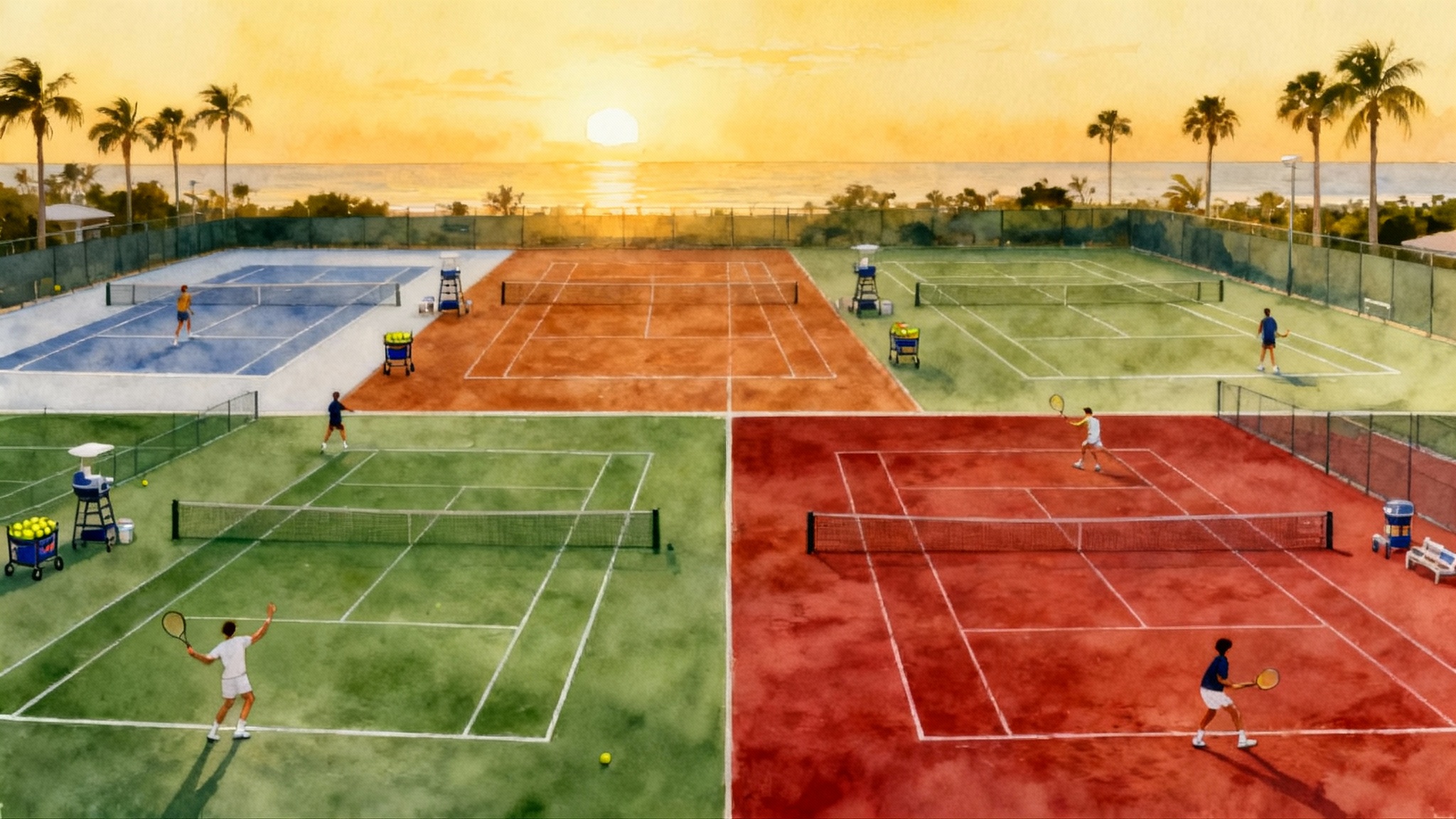Best Midwest Tennis Academies 2025–2026: Chicago to Columbus

How to use this guide
This is a parent-first, data-focused playbook for choosing a junior tennis academy in four Midwest hubs for the 2025-2026 indoor season: Chicago, the Twin Cities, Detroit, and Columbus. Instead of hype, you will find a practical rubric, realistic cost ranges, and a scheduling framework that helps you plan training, competition, and school without burning out your athlete or your budget. If you are also weighing warm-weather or East Coast options, see our Florida academies guide, Southern California academies, and New England indoor academies.
We organize the decision around eight measurable levers:
- Indoor-court access and court density
- Weekly training hours and periodization quality
- Player development measured through Universal Tennis Rating and World Tennis Number
- College placement outcomes and recruiting support
- Coaching quality and coach-to-player ratios
- Competition calendar and travel load in winter
- Total costs per season and per hour
- Schooling model and commute logistics for day versus boarding athletes
Universal Tennis Rating, often shortened to UTR, and World Tennis Number, shortened to WTN, are complementary rating systems that describe competitive level on a single scale. UTR emphasizes recent match strength and margin of victory against rated opponents, while WTN is a global scale developed with national associations that compares players across ages and genders. For quick primers, see how UTR works and the ITF World Tennis Number. Think of them as speedometers. They do not drive the car, but they tell you how fast your player is going relative to the field.
The scorecard most families wish they had
Use this 100-point checklist when you tour programs or speak with directors. Ask for written answers and sample schedules.
- Indoor access and density, 20 points
- Courts per hour available to academy blocks during peak winter weeks
- Ratio of athletes per court in each training tier
- Backup plan for snow days and peak demand
- Training hours and periodization, 15 points
- Weekly on-court hours by tier in winter and transition seasons
- Strength and mobility integrated with tennis, not bolted on
- Clear deload weeks and match tapering before key events
- Ratings development, 15 points
- Transparent plan for UTR and WTN progression with target matches per month
- Post-match video review and objective error tracking
- College placement and recruiting support, 15 points
- List of past three recruiting classes with level and roster links
- Dedicated guidance on video, emails, and unofficial visits
- Coaching quality, 10 points
- Lead coach time on court with top and middle tiers
- Coach-to-player ratio in live ball and in point play
- Competition calendar, 10 points
- Local and regional indoor events each month from November through March
- Travel distance, cost, and coach coverage at events
- Cost transparency, 10 points
- Total seasonal packages and per-hour equivalents
- Private lesson pricing, stringing, and tournament coaching fees
- School and logistics, 5 points
- Day student schedule, homework windows, test-day accommodations
- Boarding or homestay options if applicable
A program scoring 80 or more is usually aligned for steady development. A 90-plus score typically means the calendar, coaching, and match pipeline all reinforce each other.
What good looks like in numbers
These are reasonable planning targets for a serious junior competing in sectional and national events during winter. Adjust by age, training age, and injury history.
- Weekly training hours in winter: 12 to 16 on-court, 2 to 3 in strength and mobility
- Coach-to-player ratio: 1 coach for 4 to 6 players in live ball, 1 for 2 to 4 in point play
- Matches per month November through March: 8 to 12 verified matches that count for ratings
- Competition to practice ratio: about 1 match hour for every 4 to 6 practice hours
- Deload: one lighter week every 4 to 6 weeks to protect tendons and maintain freshness
Cost ranges in major Midwest metros for 2025-2026 typically look like this:
- Winter academy blocks: 30 to 60 dollars per group hour depending on tier and ratio
- Private lessons: 90 to 150 dollars per hour with lead coaches somewhat higher
- Strength and mobility: 15 to 30 dollars per session if billed separately
- Tournament coaching: 200 to 400 dollars per day plus travel share
- Stringing: 20 to 35 dollars labor per racquet plus string cost
Your real comparison should be cost per coached hour and cost per rated match supported, not just the monthly sticker. Ask each academy for a sample invoice for December or February which are the most demanding months.
City-by-city: what parents should expect
Below we do not crown a single winner. Each metro has strengths. Use the scorecard and pick based on your athlete’s needs and your family logistics.
Chicago
Profile: The Chicago area has the largest concentration of indoor courts in the region and a deep coaching bench. Demand is high on winter evenings. Noon and early afternoon blocks often have better court density. Competitive options range from city clubs to suburban training hubs.
Indoor access: Strong, but plan for drive time. The North Shore and northwest suburbs offer clusters of clubs within 20 to 30 minutes of each other, which helps rescheduling after snow or illness.
Training hours: Top groups commonly run four to five days per week with optional weekend match play. Many clubs offer tiered programming that lets a player move between competitive levels without changing coaches.
Ratings development: Expect robust match play because there are plenty of rated players in the metro. Ask how the program builds verified results during exam weeks and holiday breaks.
College placement: Chicago programs have alumni across Division One, Division Two, and strong Division Three rosters. Request a list from the past three classes with the role at entry, not just the school name.
Costs and calendars: Pricing spans the full range. Winter events are plentiful within a 90-minute radius. Build in Friday travel buffers when lake effect weather is forecast.
Day versus boarding: Chicago is primarily a day-student market. Some programs coordinate with local schools for early release or with accredited online schools for flexible blocks. Ask for sample daily timelines that include commuting windows and homework blocks.
Travel notes: O’Hare and Midway provide reliable access for regional flights. For families driving in from Wisconsin, Indiana, or downstate Illinois for weekend blocks, book daytime slots that avoid rush hour and set realistic turnaround times on Sundays.
Twin Cities
Profile: The Minneapolis-Saint Paul metro has a strong indoor culture and a network of multi-court facilities. It is a very practical winter base for day students, with a reputation for structured sessions and dependable schedules.
Indoor access: Consistent. Many facilities run centralized junior performance blocks so the court-to-athlete ratio is predictable and weather contingency plans are routine.
Training hours: Programs often emphasize quality of reps and point patterns, with three to five structured sessions per week. Cold snaps can compress schedules, so look for clubs that publish make-up policies and keep extra daytime inventory.
Ratings development: The community supports frequent match play, including weekday evening events. Families often blend in two out-of-state trips midwinter to find different opponents and fresh rating opportunities.
College placement: Recent classes often show a mix of Division One mid-major, Division Two scholarships, and selective Division Three. Ask how coaches support film, email outreach, and summer showcase scheduling.
Costs and calendars: Midrange to upper-midrange for the region. Travel costs are manageable because many events sit inside the metro. Build a February and March mini-peak with back-to-back events to consolidate rating gains.
Day versus boarding: This is a day market. Homestay or short-term apartment options exist for families who want a three to six week winter block. Confirm supervision during daytime if your athlete is on a hybrid school plan.
Travel notes: Minneapolis-Saint Paul International is efficient, which is handy for quick tournament hops to Chicago, Kansas City, Denver, or Dallas when needed.
Detroit
Profile: Detroit’s western and northern suburbs have a tight cluster of indoor clubs with a gritty, match-heavy winter culture. Parents praise the availability of competitive sets on short notice.
Indoor access: Good density of courts and a healthy ladder culture. Ask about how many courts the academy controls during peak winter hours and what happens when adult league playoffs overlap.
Training hours: Four to five days per week is common. Programs tend to build in structured point play with frequent transitions into practice sets.
Ratings development: Because many players compete weekly, match flow is steady. Confirm that the academy tracks both Universal Tennis Rating and World Tennis Number in planning. The mix of local and cross-border events into Ohio and Ontario creates variety when schedules align.
College placement: Expect a similar profile to Chicago in distribution, with a number of athletes landing at Division One mid-majors and strong Division Three programs. Push for specifics and video examples from recent recruits.
Costs and calendars: Group rates are broadly midrange. Tournament travel is car friendly. Weather can swing quickly, so plan buffers on Sunday evenings and keep spare strings in the bag when temperatures plunge.
Day versus boarding: Largely a day market. Some families build mini-camps during winter break and spring break. If school runs early, confirm that afternoon blocks start late enough to avoid daily tardies.
Travel notes: Detroit Metropolitan Wayne County Airport is a solid base for regional trips. Many winter events are within two hours by car, which keeps costs down.
Columbus
Profile: Columbus has an efficient junior ecosystem anchored by a handful of strong indoor facilities. The scene is collaborative, and travel to nearby cities adds depth when needed.
Indoor access: Good, with a premium on planning. The best experience comes when families commit to a consistent weekly block so coaches can protect ratios.
Training hours: Three to five days per week through the winter with targeted weekend match play. Look for programs that publish court maps and coach assignments before each cycle.
Ratings development: The local pool is competitive and there is quick access to Cincinnati, Dayton, and Cleveland for variety. A thoughtful winter plan can rack up verified matches without heavy flight costs.
College placement: A number of graduates move to Division Two and Division Three with some breaking through to Division One. Evaluate the substance of placement support rather than the logo board. You want guidance on email cadence, highlight film editing, and short list strategy.
Costs and calendars: Typically midrange. Because events are drivable, budget more for entry fees and less for flights. Aim for two heavier competition months, usually December and March, and lighter January training.
Day versus boarding: This is a day market with strong school partnerships and workable hybrid plans. Homestay weeks are viable for out-of-town families testing the waters.
Travel notes: John Glenn Columbus International is convenient, and many families simply drive to tournaments inside Ohio and into Michigan and Pennsylvania.
Choosing tiers and hours without guesswork
Pick a tier for your athlete that solves a real problem. If confidence and rally tolerance are limiting factors, choose a group with more high-ball volume and patterning. If closing out games is the issue, prioritize point play against slightly stronger opponents with coaching interventions between points.
Use this simple hours model for winter:
- Emerging tournament player: 8 to 10 on-court hours, 1 to 2 strength sessions, 6 to 8 rated matches per month
- Competitive sectional player: 12 to 14 on-court hours, 2 to 3 strength sessions, 8 to 10 rated matches per month
- National track player: 14 to 16 on-court hours, 3 strength sessions, 10 to 12 rated matches per month and travel blocks
If school workload spikes, protect sleep first, then trim nonessential drilling. Replace it with match charting or light technique reps that keep feel without draining energy.
Building the 2025-2026 winter calendar
The indoor season in the Midwest typically runs in three arcs.
- November to early January: Foundation and first push
- Target a two-week foundation, then a two to three week competition window around late November to mid December
- Protect two to three days off around major holidays to reset
- Mid January to mid February: Reset and precision
- Increase volume of specific patterns and serve plus one combinations
- Play one or two local events with an eye on clean wins and competitive losses
- Late February to March: Second push and taper
- Choose a two to four week stretch with back-to-back events
- Taper in the final four to six days before the peak event with reduced volume and higher quality
Ask each academy to pencil your calendar on a whiteboard during the sign-up meeting. If they cannot show how practices change before events, that is a red flag.
College placement without the smoke and mirrors
Strong academies do not promise scholarships. They build a repeatable recruiting process.
- Roster relevance: Collect the last three years of college placements from each academy and check the player’s entry role on college rosters. A walk-on is different from a scholarship starter.
- Video that works: Two minutes of clean patterns, serve plus one, return games, plus a short point sequence under pressure. Update every three months in the winter.
- Outreach rhythm: A consistent email cadence and well-planned unofficial visits over spring break beat a flurry of messages in the summer.
- Academic fit: Ask which schools the academy has strong relationships with. Then verify. You are hiring a guide, not buying a result.
Day versus boarding in the Midwest
Most Midwest academies operate as day programs. True boarding models are rare. Families build one of three schooling models that work in winter:
- Traditional school with early release: Coordinate with the school for two early days per week. Share the season schedule in advance. Ask for testing windows on light training days.
- Hybrid school: Use accredited online or hybrid programs for one or two core classes to open afternoon training windows. Protect daily live teacher time for the hardest subjects.
- Full virtual with campus hours: For national track players, a full virtual plan can work if the academy provides supervised study blocks, proctored exams, and daytime training to avoid evening crowding.
Whichever model you choose, set a weekly family checkpoint. Review school deadlines, training loads, and weekend travel so there are no surprises.
A practical visit script for each city
When you tour, bring this checklist. It turns a friendly tour into concrete answers.
- Can you show next month’s court map for my athlete’s tier and point out exact courts used each day
- What is the coach-to-player ratio in live ball and in point play for this tier
- How many verified rated matches will you help us get in December and in March, and how will you do it
- What is the plan if snow cancels our session. Can I see the make-up policy
- Please convert the seasonal price into a cost per coached hour so I can compare to other programs
- Who edits recruiting video, who reviews emails, and how do you measure progress quarter to quarter
If a program answers quickly with documents or screen shares, that is a strong sign that operations are tight. If answers are vague, expect similar vagueness when the season gets busy.
Putting it together: sample family scenarios
-
Eighth grader with multi-sport background
- Best fit: programs that offer three group sessions and one match-play block weekly
- Key ask: a gentle slope into winter volume and a focus on reliable rally tolerance over flashy winners
- Travel: mostly in-metro, one out-of-state trip in March for experience
-
Sophomore aiming for mid-major Division One
- Best fit: four to five weekly sessions split between patterns and point play, plus structured strength
- Key ask: a written ratings plan that predicts 10 to 12 verified matches per month and shows how practice themes map to common college patterns
- Travel: two winter road trips for higher-density draws and one spring break showcase
-
Senior targeting selective Division Three
- Best fit: high-quality point play and film support, plus specific doubles work
- Key ask: a short college list with realistic roles and a plan for campus visits around exams
- Travel: efficient, mostly drivable events with one higher-stakes tournament for film and competitive matches
Final checklist before you sign
- Compare court density and ratios, not just facility photos
- Demand a written training calendar with taper plans before key events
- Convert every package into cost per coached hour and cost per verified match supported
- Align school windows with training blocks and commuting time
- Confirm recruiting support deliverables and timelines
The bottom line
Chicago offers depth and density, the Twin Cities offer dependable structure, Detroit delivers frequent match play, and Columbus balances access with efficient travel. None is universally best. The right choice is the program that can prove how court access, coaching ratios, match scheduling, and school all line up for your player from November through March. Ask for the plan in writing, score it with the rubric, and choose the academy that can show how your athlete will progress week by week, not just talk about it. That is how families win the Midwest winter.





